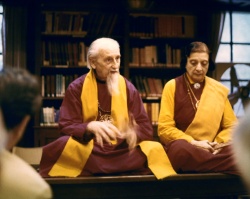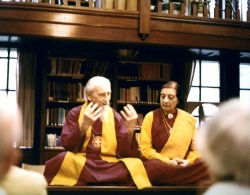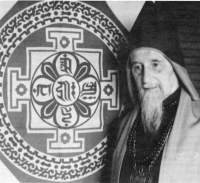Anagarika Govinda: Difference between revisions
No edit summary |
|||
| (4 intermediate revisions by the same user not shown) | |||
| Line 1: | Line 1: | ||
[[File:Lama_Govinda_AT_March_1985.jpg| | [[File:Lama_Govinda_AT_March_1985.jpg|200px|right|thumb|Lama Govinda. Photo printed with his obituary in The American Theosophist, March 1985.]] | ||
'''Lama Anagarika Govinda''' was a German Buddhist teacher of the [[Gelug-pa sect]]. He frequently wrote for Theosophical periodicals. | |||
[[ | |||
== Life == | == Life == | ||
| Line 16: | Line 8: | ||
<br> | <br> | ||
<br> | <br> | ||
According to Dora Kunz, Lama Govinda was raised as a Christian, but was interested in all religions from early boyhood. He visited Adyar and spent time with [[Charles Webster Leadbeater|Charles Leadbeater]]. He disagreed with some of Mr. Leadbeater's views on Tibet, particularly related to [[Wesak]].<ref>Dora Kunz, interviewed by Peter Michel. Audio recordings and transcripts in TSA Archives.</ref> | According to Dora Kunz, Lama Govinda was raised as a Christian, but was interested in all religions from early boyhood. He visited [[Adyar (campus)|Adyar]] and spent time with [[Charles Webster Leadbeater|Charles Leadbeater]]. He disagreed with some of Mr. Leadbeater's views on Tibet, particularly related to [[Wesak]].<ref>Dora Kunz, interviewed by Peter Michel. Audio recordings and transcripts in TSA Archives.</ref> | ||
<br> | <br> | ||
<br> | <br> | ||
Lama Govinda spent his final days, with his wife Li Gotami, at the Zen Center in Marin County, California, near San Francisco, and passed away in 1985.<ref> "Lama Anagarika Govinda," Quest Books Web page | Lama Govinda spent his final days, with his wife Li Gotami, at the Zen Center in Marin County, California, near San Francisco, and passed away in 1985.<ref> "Lama Anagarika Govinda," author bio in Quest Books Web page , accessed March 30, 2012. No longer available online.</ref> | ||
== Lectures == | == Lectures == | ||
Lama Govinda and Li Gotami sitting on a table in Olcott Library, 1977. Photos by Floyd Kettering: | In 1977, Lama Govinda lectured at the headquarters of the [[Theosophical Society in America]] in Wheaton, Illinois, and two of his talks were recorded: | ||
'''"Concepts of Buddhism"''' and '''"Development of Buddhism"'''. Here are Lama Govinda and Li Gotami sitting on a table in [[Henry S. Olcott Memorial Library|Olcott Library]], 1977. Photos by Floyd Kettering: | |||
{|style="margin: 0 auto;" | {|style="margin: 0 auto;" | ||
| [[File:Lama Govinda 1 1977.jpg| | | [[File:Lama Govinda 1 1977.jpg|250px]] [[File:Lama Govinda 2 1977.jpg|250px]] | ||
|} | |} | ||
== Writings == | == Writings == | ||
| Line 45: | Line 31: | ||
* '''''The Way of the White Clouds: A Buddhist Pilgrim in Tibet.''''' Review by Sthavira Sangharakshita in ''Theosophical Journal'' 7:4 (Jul-Aug 1966): 25. | * '''''The Way of the White Clouds: A Buddhist Pilgrim in Tibet.''''' Review by Sthavira Sangharakshita in ''Theosophical Journal'' 7:4 (Jul-Aug 1966): 25. | ||
* '''''The Foundations of Tibetan Mysticism.''''' | * '''''The Foundations of Tibetan Mysticism.''''' | ||
He was also a frequent contributor to '''''The American Theosophist''''': | He was also a frequent contributor to '''''The American Theosophist''''': | ||
| Line 64: | Line 48: | ||
* "Creative Meditation," ''The American Theosophist'' 73:3 (March 1985): 64. | * "Creative Meditation," ''The American Theosophist'' 73:3 (March 1985): 64. | ||
* ""''The American Theosophist'' 70:9 (October 1982): 64. | * ""''The American Theosophist'' 70:9 (October 1982): 64. | ||
He also wrote articles for numerous '''other Theosophical periodicals''': | He also wrote articles for numerous '''other Theosophical periodicals''': | ||
| Line 86: | Line 69: | ||
<ref>"Lama Anagarika Govinda <nowiki>[obituary]</nowiki>," ''The American Theosophist'' 73:3 (March 1985): 86.</ref> | <ref>"Lama Anagarika Govinda <nowiki>[obituary]</nowiki>," ''The American Theosophist'' 73:3 (March 1985): 86.</ref> | ||
</blockquote> | </blockquote> | ||
== Additional resources == | |||
* [http://www.lamagovinda.com/ Lama Govinda Web page.] | |||
* [https://www.theosophy.world/encyclopedia/govinda-lama-anagarika Govinda, Lama Anagarika] in Theosophy World | |||
=== Audio === | |||
* '''[https://archive.org/details/1045_20190721 Concepts of Buddhism]'''. 1977. 66 minutes. Recorded at Theosophical Society in America. This talk by Lama Govinda at the age of 79 reveals the discerning wisdom gained from a lifetime devoted to the practice and study of [[Tibetan Buddhism]] and other Eastern philosophical and religious systems. Much of this program involves Lama Govinda responding to spontaneous questions from the audience. Topics covered include [[dharma]], [[reincarnation]], transformation, [[Advaita Vedanta]], and the differences between [[Zen]] and [[Tibetan Buddhism]]. 1977. 66 minutes. Also available on [https://www.youtube.com/watch?v=58dlQRJzXuY YouTube], posted by Ákos Blázsik. | |||
* '''Development of Buddhism''' 1977. 64 minutes. In this talk he explains the historical origins of Buddhism and how it differs from Hinduism. Terms such as nirvana, karma, and ahimsa are dealt with in some detail. The recording includes questions and answers from the audience. Available on [https://www.youtube.com/watch?v=kceiS2qIG9g YouTube], posted by Ákos Blázsik. | |||
== Notes == | == Notes == | ||
<references/> | <references/> | ||
[[Category:Writers|Govinda, Lama]] | |||
[[Category:Poets|Govinda, Lama]] | |||
[[Category:Artists|Govinda, Lama]] | |||
[ | [[Category:Lecturers|Govinda, Lama]] | ||
[[Category:Pāli scholars|Govinda, Lama]] | |||
[[Category:Sanskrit scholars|Govinda, Lama]] | |||
[[Category:Buddhists|Govinda, Lama]] | |||
[[Category:Nationality German|Govinda, Lama]] | |||
[[Category:People|Govinda, Lama]] | |||
Latest revision as of 17:36, 18 December 2023
Lama Anagarika Govinda was a German Buddhist teacher of the Gelug-pa sect. He frequently wrote for Theosophical periodicals.
Life
Lama Anagarika Govinda was born Ernst Lothar Hoffman in Waldheim, Germany (old kingdom of Saxony) in 1898, the son of a German father and a Bolivian mother. He was the founder of the Buddhist Order Arya Maitreya Mandala. As a young man living in Italy, he became interested in Buddhism and meditation during the 1920s. In 1928 he moved to Ceylon (Sri Lanka) where he studied Buddhism, mastered the language of Pāli, and took his Buddhist vows. In 1931 Govinda met his Tibetan guru, Tomo Geshe Rinpoche, by whom he was initiated into the Gelug-pa sect. He spent the next thirty years in northern India, while finding time to make several trips to Tibet during the early 1930s and again in 1948-49. In 1960 he began his worldwide travels, speaking on Buddhism to audiences in Europe, North America, Japan, South Africa, Southeast Asia, and the Philippines.
According to Dora Kunz, Lama Govinda was raised as a Christian, but was interested in all religions from early boyhood. He visited Adyar and spent time with Charles Leadbeater. He disagreed with some of Mr. Leadbeater's views on Tibet, particularly related to Wesak.[1]
Lama Govinda spent his final days, with his wife Li Gotami, at the Zen Center in Marin County, California, near San Francisco, and passed away in 1985.[2]
Lectures
In 1977, Lama Govinda lectured at the headquarters of the Theosophical Society in America in Wheaton, Illinois, and two of his talks were recorded: "Concepts of Buddhism" and "Development of Buddhism". Here are Lama Govinda and Li Gotami sitting on a table in Olcott Library, 1977. Photos by Floyd Kettering:
 
|
Writings
Lama Govinda was a prolific writer on Buddhism. Among his books are these:
- Creative Meditation and Multidimensional Consciousness. It was reviewed by Jim Tweedie in Circles, No. 1 (Spring 1985):12.
- Insights of a Himalayan Pilgrim. Review by Robert Boyd in Theosophical History Vol 5 (July 1995): 253.
- The Psychological Attitude of Early Buddhist Philosophy. Review by A. N. Relton in Theosophical Journal 2:4 (Jul-Aug 1961):26.
- The Way of the White Clouds: A Buddhist Pilgrim in Tibet. Review by Sthavira Sangharakshita in Theosophical Journal 7:4 (Jul-Aug 1966): 25.
- The Foundations of Tibetan Mysticism.
He was also a frequent contributor to The American Theosophist:
- "The Significance of Meditation in Buddhism," The American Theosophist 58:11 (November 1970): 332.
- "Consciousness Expansion and Disintegration versus Concentration and Spiritual Regeneration," The American Theosophist 60:1 (January 1972): 7.
- Review of 'The Opening of the Wisdom-Eye and the History of the Advancement of Buddhadharma in Tibet' by HH Tenzin Gyatsho, The American Theosophist 60:5 (May 1972): 95.
- "Principles of Buddhist Tantrism," The American Theosophist 60:5 (May 1972): 124.
- "The Seven Auspicious Symbols of a World Ruler," The American Theosophist 61:10 (October 1973): 283.
- "The Significance of Ritual in Buddhism," The American Theosophist 65:5 (May 1977): 124.
- "Polarity and Integration [extract]," The American Theosophist 68:5 (May 1980): 107.
- "Symbols of Transformation: Reflections on the Book of Changes," The American Theosophist 69:5 (May, 1981): 122. Reprinted from Main Currents Vol 32.
- "Completeness and Transformation [excerpt Foundations of Tibetan Mysticism]," The American Theosophist 69:7 (July 1981): 195.
- "Logic and Symbol in the Multi-Dimension Conception of the Universe," The American Theosophist 69:10 (November 1981): 122. Reprinted from Main Currents 1969.
- Quotation from "The Psychological Attitude of Early Buddhist Philosophy," The American Theosophist 70:9 (October 1982): 287.
- "Buddhism as Actuality beyond Pessimism & Optimism," The American Theosophist 71:10 (October 1982): 356.
- "Creative Meditation," The American Theosophist 73:3 (March 1985): 64.
- ""The American Theosophist 70:9 (October 1982): 64.
He also wrote articles for numerous other Theosophical periodicals:
- "Pensées, " Le Lotus Bleu 92 (Avril 1987): 5.
- "Trance Walking And Lung-gom Training, " Light Bearer 14:3 (Autumn 2006): 31.
- "Consciousness Expansion: Disintegration versus Concentration & Spiritual Regeneration," Theosophy in Australia 36:5 (October 1972): 8.
- "Fundamental Principles of Meditation." Theoscientist 10:4 (1986): 8.
- "The Way of Transformation," Theosophy in New Zealand 41 (July-Sept 1980): 68.
- "Meeting with the Guru [reprint]," Theosophy in New Zealand 64 (September 2003): 7.
- "The Story of Siddha Kadgapa [reprint 1966]," Theosophy in New Zealand 64 (September 2003): 26.
- "Trance Walking and Lung-gom Training [extract Way of the White Clouds]," Theosophy in New Zealand 67 (March 2006): 8.
- "Creative Meditation," The Eclectic Theosophist 21 (Winter, 1992): 4.
In memoriam
In March, 1985, The American Theosophist published a tribute to Lama Govinda:
In January of 1985 Lama Anagarika Govinda passed on. Lama Govinda was a long-time friend of the Society, a fine Sanskrit scholar and a wise and kind man. He was born in Germany and very early in life embraced Buddhism. He studied in many European universities, but his dedication to Buddhism led him to India where he finally joined the Tibetan Buddhist order of monks. His greatest literary achievement was The Foundations of Tibetan Mysticism, an outstanding contribution to Tibetan studies and beautifully written. After living for many years in the Himalayas, he and his wife Li Gotami, a wonderful photographer, spent the last few years at the Zen Center in Marin County, California. The community there looked after im and his wife with loving care. All of us who knew him respected him greatly. The Theosophical Publishing House published one of his last books, Creative Meditation and Multi-Dimensional Consciousness, a selection from which is reprinted in this issue of The American Theosophist. [3]
Additional resources
- Lama Govinda Web page.
- Govinda, Lama Anagarika in Theosophy World
Audio
- Concepts of Buddhism. 1977. 66 minutes. Recorded at Theosophical Society in America. This talk by Lama Govinda at the age of 79 reveals the discerning wisdom gained from a lifetime devoted to the practice and study of Tibetan Buddhism and other Eastern philosophical and religious systems. Much of this program involves Lama Govinda responding to spontaneous questions from the audience. Topics covered include dharma, reincarnation, transformation, Advaita Vedanta, and the differences between Zen and Tibetan Buddhism. 1977. 66 minutes. Also available on YouTube, posted by Ákos Blázsik.
- Development of Buddhism 1977. 64 minutes. In this talk he explains the historical origins of Buddhism and how it differs from Hinduism. Terms such as nirvana, karma, and ahimsa are dealt with in some detail. The recording includes questions and answers from the audience. Available on YouTube, posted by Ákos Blázsik.
